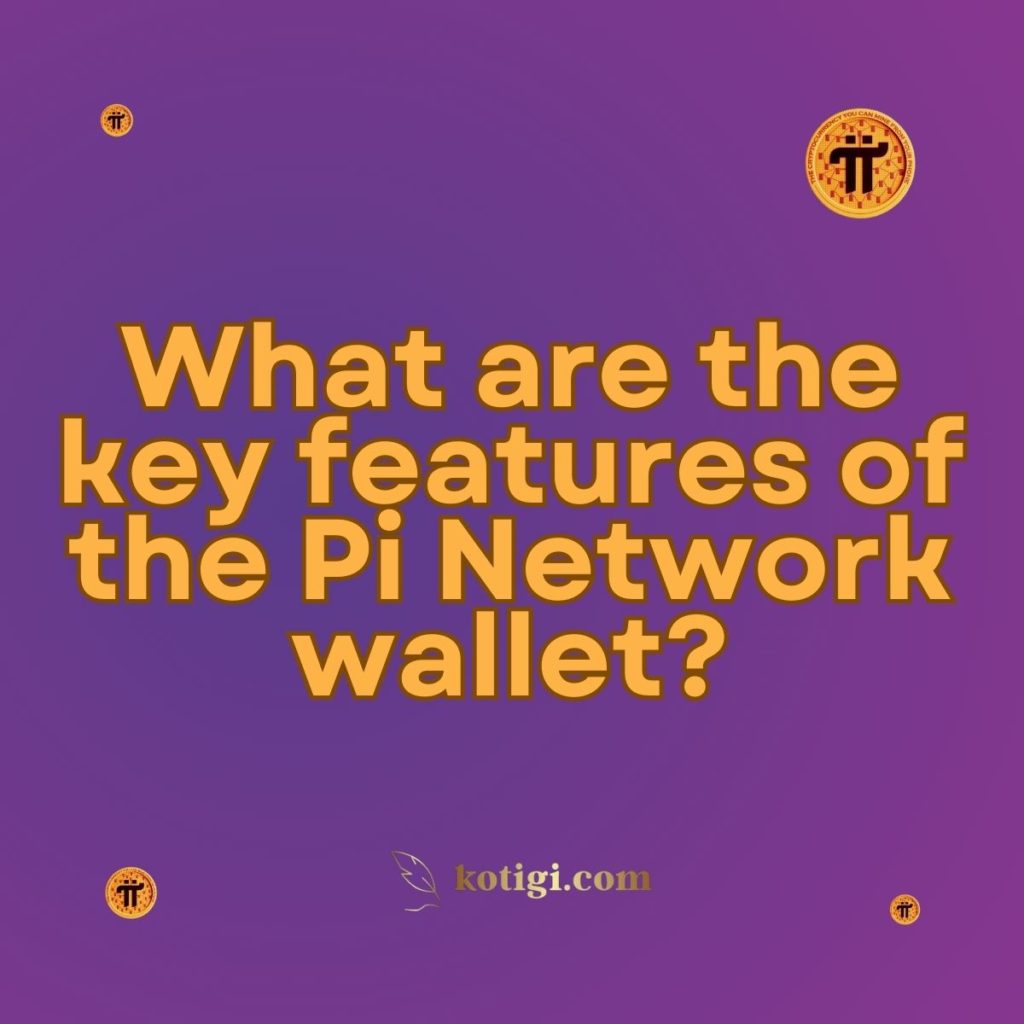
What are the key features of the Pi Network wallet?
The Pi Network wallet is a secure, user-friendly tool that enables Pioneers to store, send, and receive Pi coins. Its key features include robust security measures like a non-custodial model, a user-friendly interface, easy Pi transfers, and accessibility via the Pi Browser. These features ensure a safe and seamless experience for users managing their Pi assets.
Introduction
The Pi Network wallet plays a critical role in the Pi Network ecosystem, serving as the primary tool for Pioneers to manage their Pi coins. As a non-custodial wallet, it offers users complete control over their private keys and transactions, aligning with Pi Network’s ethos of decentralization and user empowerment. In this post, we’ll delve into the key features of the Pi Network wallet, examining its design, functionality, and security, as well as how it compares to traditional cryptocurrency wallets.
Pi Network has taken significant steps to make cryptocurrency accessible to millions of users worldwide. This wallet continues that mission by providing a simple, secure way for Pioneers to interact with their Pi holdings.
1. What is the Pi Network Wallet?
Overview of the Pi Wallet
The Pi Network wallet is the digital storage solution for Pioneers to manage their Pi coins. It allows users to send, receive, and store Pi while offering a high level of control over private keys and security. The wallet is accessible via the Pi Browser, the dedicated web browser developed by Pi Network for accessing its decentralized ecosystem.
Purpose of the Pi Wallet
The main purpose of the Pi Network wallet is to offer a decentralized and user-controlled platform for Pioneers to interact with their Pi coins. Unlike custodial wallets where third parties hold private keys, the Pi wallet empowers users to manage their own keys, ensuring privacy and security. This non-custodial approach places responsibility for security in the hands of the user, but also provides full ownership of assets.
How the Pi Wallet Works
The wallet operates on the blockchain principle, where every transaction is verified through a decentralized network of nodes. Users generate a passphrase during the wallet setup process, which serves as the key to access their wallet. This 24-word passphrase must be kept secure, as it cannot be recovered once lost. The wallet is connected to Pi’s blockchain, enabling users to conduct secure and transparent transactions without intermediaries.
2. Security Features of the Pi Network Wallet
Non-Custodial Wallet
One of the most significant features of the Pi Network wallet is that it is non-custodial. This means users retain full control over their private keys and funds. Unlike custodial wallets managed by third parties (e.g., exchanges or wallet providers), non-custodial wallets like Pi’s give users complete ownership of their assets. While this increases responsibility for keeping the private keys secure, it also eliminates the risk of third-party hacks or mismanagement of funds.
Wallet Passphrase
The Pi wallet passphrase is a 24-word key that users generate when they set up their wallet. This passphrase is crucial for accessing the wallet and recovering it in case of a device change or loss. Since the Pi wallet is non-custodial, this passphrase is the only method for regaining access to the funds. Users are encouraged to store their passphrase securely, such as in a physical safe or an offline backup.
Importance of Passphrase Security
Ensuring the security of the passphrase is critical because Pi Network cannot reset or recover the wallet if the passphrase is lost. This feature underscores the non-custodial nature of the wallet, empowering users with full control but also placing the onus of security on them.
Transaction Privacy and Security
The Pi wallet ensures that transactions are private and secure. Each transaction is encrypted and validated through the network’s consensus mechanism. Since users control their private keys, the security of transactions largely depends on how well they protect their passphrase and device.
Decentralized Security Mechanism
The Pi Network wallet leverages the decentralized nature of the blockchain to secure transactions. With nodes distributed across the network, every transaction must be validated by a consensus of the community, preventing tampering or fraud. This method ensures that Pi wallet transactions are both transparent and secure, minimizing the risks associated with centralized services.
3. User Experience and Interface
Easy-to-Use Interface
The Pi Network wallet is designed with simplicity and accessibility in mind. The wallet interface is intuitive, making it easy for both novice and experienced users to navigate. The design focuses on a clean layout, displaying critical information such as Pi balances, transaction history, and options for sending and receiving Pi clearly.
Mobile-Friendly Wallet
The Pi Network wallet is optimized for mobile use, which aligns with Pi Network’s mission of making cryptocurrency accessible through smartphones. Since the Pi Network is primarily a mobile-based platform, the wallet integrates seamlessly with the Pi Browser, allowing users to access their Pi holdings on the go.
Transaction Confirmation and Tracking
Another key feature of the wallet is the ability to easily track and confirm transactions. After sending Pi to another user, the wallet provides real-time updates on the status of the transaction. Users can view pending, confirmed, and completed transactions through a user-friendly history log.
Integration with Pi Browser
The wallet is integrated within the Pi Browser, which acts as a gateway to the Pi ecosystem. This integration allows users to interact with other decentralized applications (dApps) and features within Pi Network, such as Pi KYC, Pi Brainstorm, and the Pi Chat platform, all from a single interface.
4. Sending and Receiving Pi Coins
Simple Transfer Process
Sending Pi coins through the wallet is a straightforward process. Users simply input the recipient’s wallet address and the amount of Pi they wish to send. The wallet ensures that the transfer is encrypted and verified through the Pi Network’s blockchain, providing transparency and security.
Low Transaction Fees
One of the benefits of the Pi Network wallet is that transaction fees are minimal compared to traditional financial systems and even many other cryptocurrencies. This is particularly important for users who want to perform frequent microtransactions or send Pi coins internationally without incurring high costs.
Transaction Confirmation Time
Although transaction times can vary depending on the network’s load, the Pi Network wallet generally provides fast confirmation of transactions. Users can track the status of their transfers within the wallet interface, and receive notifications once the transfer is complete.
QR Code Support
To streamline the process of sending and receiving Pi, the wallet includes QR code functionality. This allows users to quickly scan and enter wallet addresses, reducing the possibility of input errors and making the transaction process more efficient.
5. Compatibility with Pi Ecosystem
Pi Browser and dApps
The Pi Network wallet is deeply integrated with the Pi Browser, the official portal to Pi’s decentralized applications. Through the Pi Browser, users can access various services such as Pi KYC, Pi Brainstorm, and other future dApps that will run on the Pi blockchain. This integration offers a seamless experience where users can manage their Pi coins while interacting with other elements of the Pi ecosystem.
Ecosystem Transactions
The Pi Network wallet will be an essential tool for users to participate in Pi’s upcoming decentralized economy. Whether buying goods and services within the Pi ecosystem or paying for access to dApps, the wallet will play a key role in facilitating these transactions.
Future Use Cases
As the Pi Network grows, the wallet will evolve to support more advanced use cases, such as decentralized finance (DeFi) applications, peer-to-peer marketplaces, and staking opportunities within the Pi ecosystem. This evolution will further expand the wallet’s role in the daily activities of Pi Pioneers.
6. Backup and Recovery Options
Importance of Backup
The Pi Network wallet does not have a traditional “reset password” feature due to its non-custodial nature. This makes creating a backup of the wallet’s passphrase crucial. Users should store their 24-word passphrase in a secure and offline location to ensure they can recover their wallet if needed.
Recovering the Wallet
If a user changes their device or accidentally deletes the Pi Network app, they can recover their wallet by inputting the 24-word passphrase during the wallet setup process on a new device. The wallet will then retrieve the user’s Pi coins and transaction history securely.
Best Practices for Backup
- Write the Passphrase Offline: Users are advised to write their passphrase on paper or store it in a secure offline location, such as a physical safe, to avoid digital breaches.
- Avoid Digital Storage: Storing the passphrase in cloud services, email, or other digital forms is discouraged due to potential security vulnerabilities.
7. Pi Network Wallet: Comparison with Traditional Wallets
Traditional Cryptocurrency Wallets
Traditional cryptocurrency wallets, such as Bitcoin or Ethereum wallets, offer similar features to the Pi Network wallet, including the ability to send and receive coins, transaction tracking, and private key management. However, these wallets typically require more computational resources and often involve higher transaction fees.
Key Differences
- Accessibility: The Pi Network wallet’s mobile-first approach makes it significantly more accessible compared to traditional wallets that may require additional hardware or software.
- Zero Mining Costs: While Bitcoin and other cryptocurrencies require costly mining operations, Pi Network’s wallet works in tandem with its energy-efficient mining process, making it more eco-friendly and accessible.
- Ecosystem Integration: The Pi Network wallet is closely tied to the Pi ecosystem, allowing users to engage with dApps and services within the same interface. Traditional wallets usually focus on financial transactions only.
User Experience
The user experience in Pi Network’s wallet is tailored to simplicity, making it easier for those new to cryptocurrency. Traditional wallets, particularly for more complex chains, often require a deeper understanding of blockchain mechanics, which can be a barrier for new users.
Conclusion:
The Pi Network wallet offers a secure, user-friendly solution for managing Pi coins, aligning with Pi’s mission of making cryptocurrency accessible to everyone. With features like non-custodial ownership, integration with the Pi ecosystem, and minimal transaction fees, it provides an efficient and transparent way for Pioneers to engage with their Pi holdings. The wallet’s easy-to-use interface, security measures, and future compatibility with dApps make it a crucial tool for both current and future Pi users.
Key Takeaways:
- The Pi Network wallet is a non-custodial wallet, giving users full control over their private keys and Pi coins.
- A 24-word passphrase is required to access and recover the wallet, emphasizing security and user responsibility.
- The wallet offers fast, secure transactions with minimal fees, making it ideal for microtransactions within the Pi ecosystem.
- Integration with the Pi Browser enables users to access decentralized applications (dApps) and participate in Pi’s growing ecosystem.
- Users must securely back up their passphrase as it cannot be recovered if lost.





